
Fort Sumter is a sea fort built on an artificial island protecting Charleston, South Carolina from naval invasion. Its origin dates to the War of 1812 when the British invaded Washington by sea. It was still incomplete in 1861 when the Battle of Fort Sumter began the American Civil War. It was severely damaged during the war, left in ruins, and although there was some rebuilding, the fort as conceived was never completed.
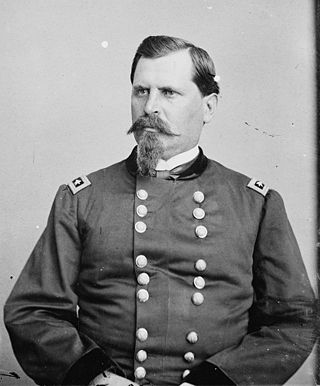
William Babcock Hazen was a career United States Army officer who served in the Indian Wars, as a Union general in the American Civil War, and as Chief Signal Officer of the U.S. Army. His most famous service was defending "Hell's Half Acre" at the Battle of Stones River in 1862, and seizing Fort McAllister, Georgia, in December 1864, which allowed William Sherman to capture Savannah at the end of his March to the Sea.

The first USS Weehawken was a Passaic-class ironclad monitor in the United States Navy during the American Civil War. She was named after Weehawken, New Jersey.
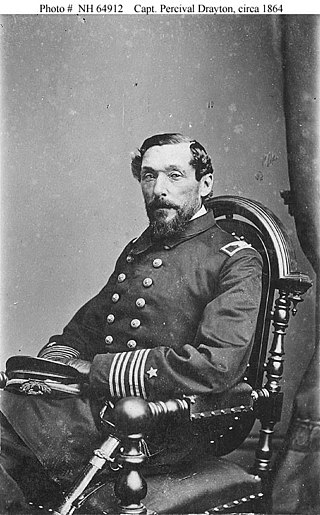
Percival Drayton was a career United States Navy officer. He served in the Brazil Squadron, the Mediterranean Squadron and as a staff officer during the Paraguay Expedition.

USS Seneca was a Unadilla-class gunboat built on behalf of the United States Navy for service during the American Civil War. Seneca was outfitted with guns for horizontal fire as well as with two howitzers for bombardment of shore targets. With her crew of 84, she was assigned to the Union blockade of the Confederate States of America.

USS Patapsco was a Passaic-class ironclad monitor in the United States Navy during the American Civil War. She was named for the Patapsco River in Maryland.

The first USS Montauk was a single-turreted Passaic-class monitor in the Union Navy during the American Civil War.
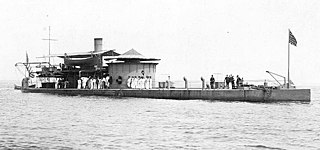
The first USS Nahant was a Passaic-class ironclad monitor of the United States Navy that saw service in the American Civil War and the Spanish–American War.

The siege of Fort Pulaski concluded with the Battle of Fort Pulaski fought April 10–11, 1862, during the American Civil War. Union forces on Tybee Island and naval operations conducted a 112-day siege, then captured the Confederate-held Fort Pulaski after a 30-hour bombardment. The siege and battle are important for innovative use of rifled guns which made existing coastal defenses obsolete. The Union initiated large-scale amphibious operations under fire.
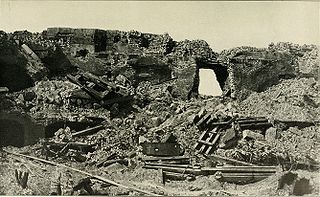
The Second Battle of Fort Sumter was fought on September 8, 1863, in Charleston Harbor. Confederate General P. G. T. Beauregard, who had commanded the defenses of Charleston and captured Fort Sumter in the first battle of the war, was in overall command of the defenders. In the battle, Union forces under Major General Quincy Gillmore attempted to retake the fort at the mouth of the harbor. Union gunners pummeled the fort from their batteries on Morris Island. After a severe bombing of the fort, Beauregard, suspecting an attack, replaced the artillerymen and all but one of the fort's guns with 320 infantrymen, who repulsed the naval landing party. Gillmore had reduced Fort Sumter to a pile of rubble, but the Confederate flag still waved over the ruins.
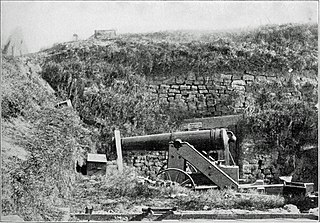
The Second Battle of Fort McAllister took place December 13, 1864, during the final stages of Maj. Gen. William T. Sherman's March to the Sea during the American Civil War. Union forces overwhelmed a small Confederate force defending the strategically important Fort McAllister near Savannah, Georgia, a major Federal objective.
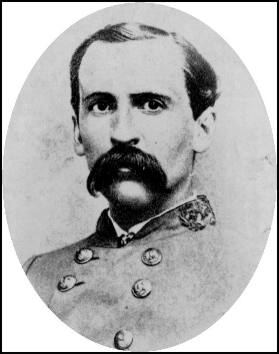
Robert Houstoun Anderson was a West Point graduate, an infantry officer in the United States Army and later served as a Brigadier General in the Confederate States Army during the American Civil War, After the war he served as the Chief of the Police for the city of Savannah for 23 years and was twice appointed to serve on the Visitor's Board of the United States Military Academy at West Point, New York, NY. He played an important role with reunification efforts after the war.

The First Battle of Fort McAllister was a series of naval attacks that took place from January 27 to March 3, 1863, in Bryan County, Georgia, during the American Civil War. The commander of the South Atlantic Blockading Squadron Rear Adm. Samuel F. Du Pont decided to test operation of new monitors against Fort McAllister before conducting a major naval operation against Charleston, South Carolina.

USS Unadilla was a Unadilla-class gunboat built for service with the United States Navy during the American Civil War. She was the lead ship in her class.

USS Huron was a Unadilla-class gunboat built for the United States Navy during the American Civil War for blockage duty against the ports and rivers of the Confederate States of America.

Major George Wayne Anderson Jr, was an officer in the Confederate States Army during the American Civil War. He commanded the Republican Blues and later Fort McAllister near Savannah, Georgia before its capture in 1864.

The Republican Blues were a military company formed in Savannah, Georgia. The Blues were first organized in 1808 and served at Fort Jackson and in Florida during the War of 1812. The Blues, typical of Savannah's old military units, were a fraternal social organization and a well-trained military unit. The Blues defended Georgia's coast from the Union Navy between 1861 and 1864. Unlike most Confederate units formed during the Civil War, the Republican Blues had been an existing militia organization for over fifty years before the war started. They recruited from the most prominent families in and around Savannah. They fought in all the nations wars after The Civil War as part of the Georgia National Guard, with the lone exception being The Spanish–American War. Today they remain in service, as a modular artillery brigade of the Georgia Army National Guard, the 118th Field Artillery.
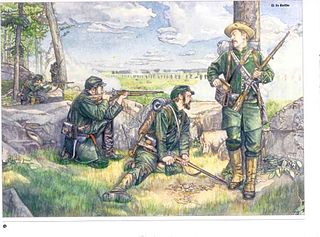
The 1st Georgia Sharpshooter Battalion was a sharpshooter unit of the Confederate States Army during the American Civil War. It was authorized by an act in April 1862 by the Confederate Congress, and was formed in Savannah, Georgia. The 1st Battalion Sharpshooters served at Fort McAllister defending the coast of Georgia in the Battle of Fort McAllister (1863). They also saw action at the Battle of Jackson, Mississippi as well as the Battle of Chickamauga, and the Chattanooga Campaign. The battalion fought to the end of the war, their last engagement being at the Battle of Bentonville in March 1865.
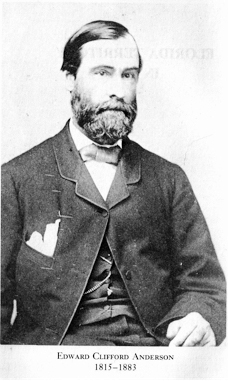
Edward Clifford Anderson Sr. was a naval officer in the United States Navy, Mayor of Savannah, Georgia and a Colonel in the Confederate States Army during the American Civil War. He commanded Fort James Jackson near Savannah before its capture in 1864. He was elected mayor of Savannah eight times, before and after the war, and on December 6, 1865, he became the first mayor to be elected after the war.

Lebanon Plantation is a state historic site located at 5745 Ogeechee Road in Savannah, Georgia. The site is over 500 acres (2.0 km2) consisting of a large estate granted to James Deveaux in 1756, and was named for the many cedar trees on the property. An additional 500 acres were granted to Phillip Delegal in 1758 and eventually became part of the plantation. The site was purchased by Joseph Habersham in 1802. Habersham sold it in 1804 to George W. Anderson who built the main house that was rebuilt and added on to after the American Civil War. Anderson's son, George Wayne Anderson, JR Commanded Fort McAllister in the Civil War, and after the fort fell, Lebanon became his prison and the headquarters of the Fifteenth Army Corps of the US Army.


























